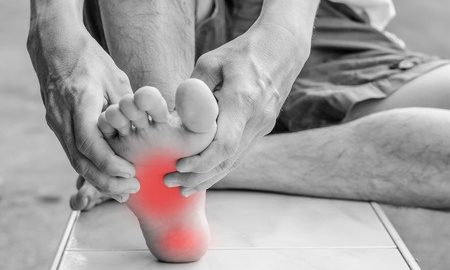Healing Diabetic Foot Ulcers May Become Easier

Researchers at Egypt’s Mansoura University have shown that mesenchymal stem cells hold promise in healing recalcitrant foot ulcers in patients with diabetes. In a study led by Ahmed Albehairy, MD, the scientists used a local injection of autologous bone-marrow-derived stem cells and found it greatly reduced ulcer size.
Approximately 15 percent of diabetics suffer from neuropathic foot ulcers. These open sores typically develop on the bottom of the feet due to a lack of feeling in the foot, irritation, and poor circulation. Foot ulceration is preventable, but if left untreated, it can lead to limb amputation. In fact, approximately 85 percent of diabetes-associated amputations are preceded by ulcerations. Patients typically do not feel any pain from the ulcer due to neuropathy (loss of sensation). However, they may notice a foul-smelling drainage, redness, and swelling.
The researchers in Egypt followed patients in both the treatment arm and the control arm of the study 6 and 12 weeks after the injection. At 6 weeks, patients who were treated with the stem cell injection showed a nearly 50 percent reduction in ulcer size compared to a less than 8 percent reduction for people in the control group. Twelve weeks after treatment, the ulcer reduction was 68 percent and 5 percent in the treatment and control group, respectively.
Diabetic foot ulcers are notoriously resistant to treatment. It is believed that the mesenchymal stem cells stimulate the formation of new blood vessels (angiogenesis) at the site of injection. This improves circulation and helps heal the wound. The stem cells also reduce inflammation and prevent the formation of scars.
As many as one in four patients with foot ulcers go on to require an amputation of their leg, which is why researchers are focused on finding a treatment for them. Both allogeneic and autologous stem cells are being studied. The use of stem cells to treat critical limb ischemia in patients with diabetes is also under investigation.
Earlier this year, researchers at the Sackler School of Graduate Biomedical Sciences at Tufts University established that skin cells obtained from diabetic foot ulcers are pluripotent. In other words, these cells can be programmed to their earliest embryonic state. Called induced pluripotent stem cells, they hold great promise in the treatment of chronic wounds.
The team also discovered a link between wound healing and a protein called fibronectin. What this essentially means is that cells from diabetic foot ulcers can be pushed back to an undifferentiated state and then turned into cells that are necessary for wound healing, explains Jonathan Garlick, PhD, DDS, of Boston’s School of Dental Medicine.
Experts in the field, such as Dr. Andrew Boulton, from the University of Manchester in the UK, are cautiously optimistic. Further randomized studies are needed to confirm these findings and ensure these treatments are safe and effective.
References:
- http://www.medscape.com/viewarticle/869455
- http://www.apma.org/Learn/FootHealth.cfm?ItemNumber=981
- http://now.tufts.edu/news-releases/non-healing-tissue-diabetic-foot-ulcers-reprogrammed-pluripotent-stem-cells


